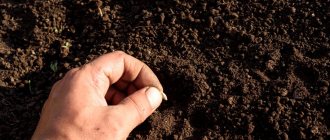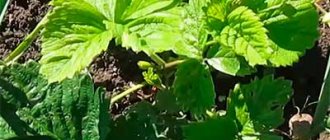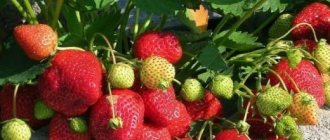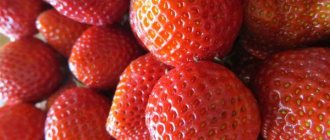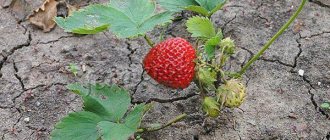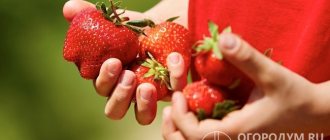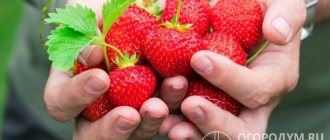Description of the variety
The plant has powerful bushes and strong peduncles that hold berries well, with an average weight of 100-125 g. The height of the bush can reach 40 cm and a diameter of 50 cm. The wide leaves are painted in a matte light green color. Their shape resembles a trefoil. The surface of the leaves is corrugated.
Among the advantages of strawberries:
- pleasant taste and aroma of fruits;
- large beautiful berries;
- good resistance to drought and low temperatures;
- high degree of resistance to most diseases.
The plant belongs to the early giants. In the first year, 1-2 flower stalks appear on the bush. An ovary of -10 berries is formed on them. In the second year, the bushes throw out up to 6 flower stalks.
Important! High yields from strawberries can be expected only from the 2nd year of cultivation.
In Russia, the variety is rare. Its disadvantages include the difficulty of acquiring planting material.
Reviews from gardeners
Strawberries called “Kamrad Winner” have positive reviews and high praise from both professional and novice gardeners. This very early variety produces berries that are simply gigantic in size and weight, the weight of which, with good and proper care, can vary from 40 to 100 g. The first berries are especially large.
The taste is excellent. The berries are very sweet, with tender and aromatic pulp. The bright red pulp has a high sugar content. The description of the variety suggests very good drought and frost resistance, which is confirmed by reviews from gardeners.
Reproduction
Strawberries are grown using seedlings. A separate bed is being prepared for new plantings. You can grow seedlings yourself from seeds or buy ready-made planting material. For planting in the ground, seedlings with a well-developed root system are selected. The length of the white roots should be at least 3-5 cm, and the diameter of the bark neck should be 6 cm.
Important. Old bushes are replaced 5-6 years after planting.
Seedlings should have a whole apical bud and 3-5 leaves. Bushes intended for planting cannot be kept out of the ground for a long time. If the purchased seedlings cannot be immediately planted in the beds, they need to be buried in moist soil or the roots should be wrapped in damp moss.
Landing
The ideal soil for “Comrade of the Winner” is considered to be chernozem mixed with a small amount of peat. Its productivity depends on the correct planting. It starts with preparing the beds. They are located in a well-lit area. Soil with high acidity is treated with lime a year before planting. It is added to the soil at the rate of 1 cup per 1 sq.m.
Recommended:
- Plant at a distance of 50-55 cm. The row spacing should be 70 cm.
- Add a small amount of humus and 1 liter of warm water to the planting hole.
- Plant strawberries in cloudy weather.
- After planting, water by sprinkling every day for 1 week.
Important. After placing the seedlings in the hole, it is covered with earth, periodically compacting the soil so that there are no voids left in it.
The root collar of the bush is buried at the same level as the soil surface. Before planting, the roots are well straightened. The roots should not be exposed during watering. It is better to place the beds in east-west directions. This ensures maximum illumination.
Strawberry variety Kamrad Winner
Kamrad Pobeditel is a non-repairing variety of garden strawberries (strawberries) of medium late ripening, universal use. It is the brainchild of German breeders. Famous for its large fruit, it belongs to the symbolic group of giant varieties. It is also valued for its good taste, excellent immunity to disease and the ability to adapt to different climatic conditions. The variety is “long-lived” and can be grown for about 7 years without renewal, without reducing the yield or losing its excellent taste.
The plant is powerful, tall (35−40 cm), abundantly leafy, spreading. The mustache is powerful, thick, and is formed in small quantities. The leaves are wide, strongly corrugated, dark green in color. The flowers are large and white. Strawberry flower stalks are powerful, strong, very thick, located at the level of the leaves or higher, and are laid on the ground under the weight of the fruit. Comrade Winner forms quite a few flower stalks, in the first year of life only 1-2 pieces, in subsequent years - up to 6. Each of them can bear up to 10 berries.
The fruits of the variety are really huge, mostly comb-shaped, and can be broadly conical, without a neck. The skin is bright red and shiny. The achenes are yellow, shallowly pressed. The pulp is red, very dense, but not hard, with a fleshy consistency, without voids, very juicy and aromatic. The taste of strawberries is excellent. The berries are very sweet, but there is a barely noticeable elegant sourness. In general, gardeners like the taste of Comrade Winner, but they admit that it is not particularly outstanding - the same as Gigantella, which is also not famous for any “zest” in its taste palette.
The fruits are universal in consumption, excellent fresh, and are excellent for any processing and freezing. Thanks to their dense pulp, they are easily transported and easily tolerate short-term storage. Externally, the berries look very impressive - not strawberries, but apples! In the market, of course, Kamrad the winner could be in great demand, but for commercial purposes it is grown extremely rarely, living mainly on the plots of gardeners and amateur collectors as a rare valuable specimen. Why is it this way? Let's figure it out.
So, the giant variety produces truly huge berries weighing from 60 to 150 grams; they can reach 7 cm in diameter. The largest specimens are observed during the first harvest, but subsequent fruits are striking in size. It is worth saying that our hero is considered one of the largest-fruited, surpassing in this regard the famous Gigantella Maxim and the recently popular Japanese masterpieces Chamoru Turushi and Tsunaki. But not everything is so rosy. In terms of yield, Kamrad the winner is inferior to the above-mentioned fellow giants, and quite significantly. The fact is that although its berries are large, there are very few of them. According to reviews from gardeners, strawberries form very few flower stalks (as a rule, no more than three), and there are even fewer fruits on them - often one large “apple” ripens, sometimes it is possible to observe 3-4 pieces. Thus, even if we assume that you are lucky and absolutely all the berries are gigantic, the yield will not exceed 1.5 kg per bush. But if we return to reality, such an indicator will become just a dream. The maximum you can count on is up to 1 kg per plant. On average, the yield is approximately 500−800 grams. Of course, it depends on agricultural technology, so who knows, maybe you will be able to collect more than 1.5 kg of berries from a bush. Of course, it’s better not to even dream about the exorbitant 3 kg per plant, as the advertising of Chamora Turusi and Tsunaki shouts, although for these two Japanese women such a figure is also not entirely realistic, so you shouldn’t immediately take your eyes off the victorious Comrade.
The variety ripens in the mid-late period, but in different regions it can start the season either earlier or later, which is why confusion sometimes arises - some consider these strawberries to be late, others - mid-ripening, and others generally classify them as mid-early. The variety bears fruit once, but at the same time it is very extended. This happens because the berries take a very long time to ripen. Gardeners complain that because of this nuance they do not have time to taste the harvest - insects, slugs, birds and other “neighbors” are already tasting it.
Comrade the winner has excellent immunity, and in general, he is very “tenacious”, he can calmly exist on the site even without any care. But, of course, if you want to get tasty and abundant harvests, then you should take care of the plants. It is still necessary to carry out preventive treatments against diseases and pests in a timely manner to avoid surprises. By the way, this strawberry is very loved by various residents of the site - insects, birds, mice, moles. Therefore, take all necessary measures to protect the harvest from unnecessary mouths.
The variety has quite decent winter hardiness; in the northern regions it winters quite well under cover, without attacks. Spring frosts are also not particularly dangerous for plants. Strawberries have a high level of drought resistance, as well as heat resistance, which makes them very attractive for growing in southern regions with hot summers. Of course, to obtain better yields, it is necessary to provide the plants with regular, abundant watering, and it would also be a good idea to think about shading the plantings to protect the berries from the scorching sun.
In agricultural technology, the variety is quite standard; it requires the most basic care measures. The winner's comrade can be classified as a “strawberry for the lazy” group, but one should not expect excellent yields with minimal attention to the plants. The main thing that needs to be emphasized is providing the plantings with sufficient nutrition. This is especially important if you want to see apple-sized berries on the bushes. The main preference is given to mineral complexes; organic matter is added before planting and before flowering. Another agrotechnical nuance - avoid excessive thickening. Considering the size of the bushes, they should be planted at a distance of 50 cm; it is better to leave 70 cm between rows. This planting scheme cannot be called compact, so a reasonable question arises - maybe it is better to plant two bushes of a different variety in a certain area? If you are interested in a higher yield of berries per square meter of area, then it is definitely worth it. But since our hero is currently more of a “museum exhibit,” we will not talk about commercial cultivation in pursuit of productivity.
The variety is valued for its longevity. It can bear fruit stably over 5-7 years of use, maintaining the excellent taste of the berries and quite good yield. In fact, at present this quality is quite rare, especially for very large-fruited varieties, so Kamrada winner can to some extent be called special among the assortment of giant varieties.
What would I like to say at the end? This strawberry is very good, has decent taste, is easy to care for, and has excellent resistance to various diseases. And for those who want to have a curiosity on their plot that bears fruit like berries, apples, and, moreover, does not have a “foam” taste, Kamrad the winner will be a good purchase. Unfortunately, it is not particularly promising for commercial cultivation, and many gardeners abandoned it due to insufficient yield. But for connoisseurs of varieties that are different from the mass of others, our hero is very attractive and will become a wonderful unique “highlight” on the site.
Watering
With proper watering, the berries grow large and juicy. Watering is carried out:
- On sunny days, 2 times a week using sprinkling method.
- In cloudy weather, strawberries are watered no more than once a week.
- During the ripening period, the frequency of watering is once every 10 days.
In cool weather, reduce the amount of watering. Moistened soil must be loosened.
Important. Water for irrigation must have a temperature of at least 18 degrees.
Some of the ordinary water for irrigation can be replaced with herbal infusions. The last abundant watering of strawberries is done 1 month before the onset of frost.
Landing technology
If all factors are taken into account, Kamrad will not be long in coming as a winner if planted correctly in the second year with a bountiful harvest.
- First, the site for planting the variety is prepared. Ideally, it should be well lit with maximum sunlight. In addition, it should be possible to protect strawberries from drafts. When preparing the beds, it is important not to forget to dig up the soil thoroughly.
- If the soil under the berry is highly acidic, it can be reduced with lime. Digging should be done with the simultaneous application of organic fertilizers. If the event was missed at the preparatory stage, you can compensate for the lack of fertilizers during the planting process.
- The best direction for forming beds is the East-West side due to the greatest amount of sunlight.
- Seedlings should be planted a maximum of 60 cm apart from each other. The space between rows should ideally reach 70 cm.
- The final stage of all activities is watering the Kamrad Pobeditel strawberries. Monitor soil moisture more closely in the first couple of weeks after planting. Further, it is recommended to reduce the number of waterings to 1-2 per week.
These tips will help you get a high-quality harvest from the rare plant Kamrad Pobeditel.
Care and feeding
During the entire period of growing strawberries, weeds are pulled out from the beds, the soil is loosened and pests are controlled. Loosening begins immediately after the appearance of flower stalks. During this period, tree resin is recommended to be added to the soil. 2 cups of ash are added per 1 sq.m of soil. For good plant growth, strawberries are fed with biofertilizers. An effective means for watering is nettle infusion.
The grass is filled with water and infused for at least 3 days. The infusion is sprayed on the bushes during the formation of the stem and the release of flower stalks. Top dressing is made from mullein and a solution of zinc sulfate 0.02%. To prevent the berries from falling to the ground and rotting, the bushes of the plant are sprinkled around the circumference with river sand.
Important. Before strawberries bloom, it is recommended to trim the tendrils.
Circumcision is performed early in the morning or late in the evening. This is done using garden shears. You cannot tear off your mustache with your hands. They are very strong. If they are torn from the stem, the bush can be damaged.
When leaving it is recommended:
- Be sure to loosen the soil at the end of summer.
- Do not dry out the soil before frost.
- In the fall, cover the bed with spruce branches or dry raspberry branches.
- To facilitate maintenance, they are covered with agrofibre.
The first feeding is carried out in early spring. To do this, use ammonium nitrate in the amount of 1 tablespoon per 1 sq.m. Ash is used as dry fertilizer. At least 2 glasses are scattered per 1 square meter.
In the summer, strawberry bushes are sprayed with a solution containing:
- 1 bucket of water;
- 1 cup wood ash;
- 1 cup garlic.
This product helps get rid of plant pests. During the formation of fruits, it is recommended to feed the berries with “Ovary” fertilizer. Before winter, all weeds and diseased plants are removed from strawberry beds. They themselves are covered with branches or covering material.
Features of growing strawberries Kamrad
Near the ground, in the thick foliage,
Like sun glare
Captivating everyone with beauty,
Strawberries are ripening.
For each of us, strawberries are associated with childhood, hot summers, and the desire to eat a delicious berry. For hours, with pleading eyes, we stand at the feet of our mother or grandmother and wait for the next portion of delicious food. But it’s sad that the berries don’t ripen as quickly as we would like. And now we have grown up, matured, but the love for strawberries has not disappeared anywhere.
Today I want to introduce you to my favorite variety, Kamrad - the most juicy, sweet and huge berry.
Characteristics of the variety
Kamrad is a strawberry variety from Germany. Externally, the berry bush is quite tall - it grows up to 40 centimeters. The leaves are wide, dark green, the flowers are white. During the year it produces up to 2 flower stalks, on which more than 10 berries ripen.
Kamrad Pobeditel belongs to the varieties of large-fruited strawberries. When first planted, the berries grow very large, reaching a weight of 40 to 100 grams. The fruit itself is bright red, shiny, juicy and sweet.
Preparing a site for planting strawberries
The harvest will depend on how well and correctly you prepare the area for planting strawberries.
The area for planting Kamrad must be prepared in advance: leveled and fertilized. The amount of minerals must correspond to the fertility of the soil.
If you are sure that this area will produce a good harvest, it is not advisable to apply a lot of fertilizers. If you decide to plant strawberries in a new area for the first time, you should enrich the soil a little.
Humus or compost can be used as organic fertilizers when digging up the soil.
Before planting, the area must be dug up, with an emphasis on a depth of up to 40 cm, since the strawberry root system develops precisely to this depth.
Technology of planting seedlings Kamrad
When the plot is completely ready, you can start planting strawberries. It is recommended to form the beds at a distance of up to 70 cm from each other, from sunrise to the west, since this variety loves the sun very much. The distance between bushes is 50 cm.
If the area is not fertilized enough, add humus to the dug hole, then cover it with a layer of soil and plant a strawberry bush.
After planting, we irrigate by sprinkling to the root depth. During the week, once every two days, we slightly moisten the soil. During this period, the seedlings should take root.
Strawberry care
During the entire period of strawberry ripening, seedlings should be carefully looked after: pull out weeds, loosen the soil, moisten it, and fight pests.
As soon as the seedling produces a flower, loosen the soil and sprinkle it with wood ash. In this case, you should adhere to the proportion of 2 cups of ash per kV. meter.
After such actions, you should feed the strawberries with biofertilizers. One of the proven methods that most gardeners recommend is spraying with nettle infusion.
To prepare the infusion you will need:
- Bucket of chopped nettles
- Warm water
Nettle is filled with water and infused in a dark place for 3 days. The bush is sprayed with this solution during stem formation and flowering, which promotes the growth of strawberries and their fruits. Also, seedlings are fed with mullein and a solution of zinc sulfate 0.02%.
Since the Kamrad Pobeditel strawberry fruit is quite large, it tends to lie on the ground. To prevent the berries from rotting, the strawberry bushes are sprinkled with a 5-centimeter ball of river sand - it removes excess moisture.
In order for the berry to grow juicy, you should know the rules for watering strawberries:
- Water by sprinkling once a week, on sunny days - 2 times a week.
- During the ripening of the fruit, when the berries turn red, water once every 10 days, depending on the air temperature.
- After moistening, when the soil dries slightly, it is necessary to loosen the soil.
The following tips are important for disease prevention and pest control:
- Once a month, the leaves are sprayed with an infusion of garlic and ash. A glass of chopped garlic is infused in warm water for 24 hours, then filtered and sprayed on the bushes.
- To prevent moles and other pests from spoiling the strawberry roots, garlic is planted along the entire perimeter of the bed.
Another important point that must be taken into account when growing Kamrad is trimming the antennae. This procedure should be carried out before the bush blooms or after harvesting. On a windless and warm day, early in the morning or evening, use a knife or scissors to trim the strawberry tendrils. You cannot tear them off, as the tendrils are very strong and pulling them out can damage the bush and root system.
Diseases and pests
Manufacturers produce special preparations to control pests. The most popular of them are “Fitosporin” and “Colloidal sulfur”.
Among the factors that weaken plants and reduce resistance to disease:
- lack or excess of nutrition;
- excessive dryness or moisture in the soil;
- weeds.
In early spring, before the bushes appear, the beds are watered with hot water from a watering can. Its temperature should not be lower than 60 degrees. You can add a little potassium permanganate or copper sulfate to the water.
Among the most commonly used means for controlling pests and diseases of strawberries:
- Iodine. Used for spraying plants. The solution is prepared from 15-20 drops and 10 liters of water.
- Garlic infusion. Take 150 g of garlic per bucket of water.
- Mustard powder. The solution is prepared from 10 liters of water and 2 tablespoons of dry powder.
- Serum. The ratio of ingredients in the solution is 1:10.
To combat fungus, plants use chemical fungicides, and biological insecticides against harmful insects.
Important. To protect the plant from pests, you can plant garlic in the aisles.
The pests that cause the most damage to strawberries are:
- Nematode. Caused by small worms that burrow into the plant. Affected bushes are burned. The soil is subjected to special treatment, and the bed is moved to another place.
- Strawberry mite. Completely destroys plants. Prevention of infection of strawberries is disinfection of seedlings before planting.
- Spider mite. It entangles strawberry bushes in garden cobwebs, which leads to drying out.
- Aphid. Clings to the leaves and stems of the plant. To combat insects I use garlic solution.
Enemies are wasps and birds.
Among the most common types of berry diseases:
- fusarium and late blight wilt;
- powdery mildew;
- gray rot;
- brown leaf spot.
Fungus on strawberries most often appears in beds that have not been cleared of old plants and weeds. They must be completely removed from the site before winter. In the spring, strawberries are sprayed with various chemicals to prevent infection. The most effective among them are Falcon and Euparen. Ordan is used for autumn spraying.
To maintain the health of the berries, it is necessary to comply with all growing conditions necessary for normal plant growth. Soil treatment, timely watering and fertilizing will eliminate the hassle of treating tangle diseases and controlling pests. To breed a variety, you should not buy its seedlings from strangers. Currently, “Kamrad Winner” can be found in gardening nurseries.
It is very useful to periodically change the location for setting up strawberry beds. It is not recommended to plant on areas of land previously occupied by colorful flowers. It is good to plant herbs next to the beds to repel pests. For example, lupins.
